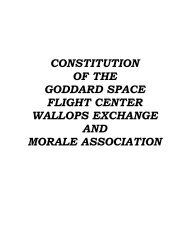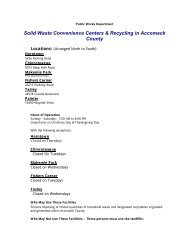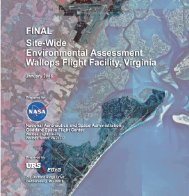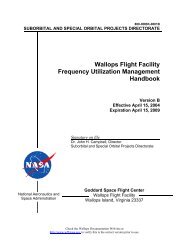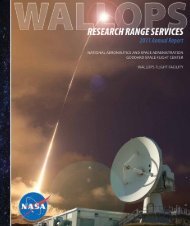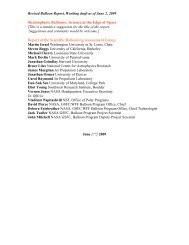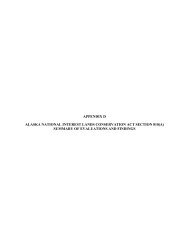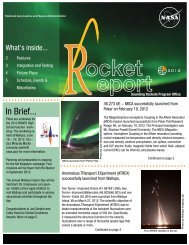Phil Eberspeaker - Wallops Flight Facility - NASA
Phil Eberspeaker - Wallops Flight Facility - NASA
Phil Eberspeaker - Wallops Flight Facility - NASA
Create successful ePaper yourself
Turn your PDF publications into a flip-book with our unique Google optimized e-Paper software.
Single stage Orion lift-off from <strong>Wallops</strong> Island.<br />
6 Sounding Rockets Annual Report 2007<br />
Executive Summary<br />
Sounding Rockets Support <strong>NASA</strong>’s Strategic<br />
Vision and Goals<br />
<strong>NASA</strong> strategic objectives for Earth Science, Heliophysics, and<br />
Astrophysics are supported by core science missions conducted by the<br />
Sounding Rockets Program. Sounding rockets are also used to support<br />
other strategic objectives of <strong>NASA</strong> such as Aeronautical research and<br />
low-cost test beds for Exploration.<br />
2007 Missions and Accomplishments<br />
Ten science investigations involving 17 vehicles were launched in 2007:<br />
•<br />
•<br />
•<br />
The Poker Flat campaign, January - February 2007, included ten<br />
vehicles with four distinct science objectives.<br />
Several telescope missions were launched from White Sands<br />
Missile Range in New Mexico. The new Celestial Attitude Control<br />
System (CACS) performed exceptionally well during its first<br />
operational flight on the Long-Slit Imaging Dual Order<br />
Spectrograph (LIDOS) mission.<br />
Two payloads were flown from Andoya Rocket Range in Norway<br />
for the MASS mission, which measured properties of<br />
Noctilucent Clouds (NLCs). These launches were coordinated<br />
with the AIM (Aeronomy of Ice in the Mesosphere) satellite and<br />
were part of an international collaborative research campaign<br />
that included other launches.<br />
New Program Capabilities<br />
Several new capabilities were implemented in 2007. As noted above,<br />
CACS was tested and successfully flown on its first operational mission.<br />
A tailored trajectory allowing nearly horizontal flight was successfully<br />
accomplished for only the second time using a new and improved<br />
ACS. Additionally, the S-19 guidance system was upgraded with a new<br />
guidance sensor, and the program’s launch capability was enhanced<br />
with refurbishment of the new Athena Launcher, which was subsequently<br />
installed in Norway.



